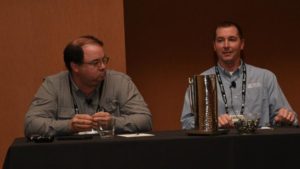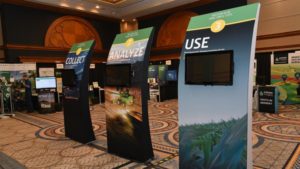Ag Tech Sunday - John Deere looking for some of the agronomy pie
- By: "Farm Tender" News
- Ag Company News
- Feb 09, 2019
- 808 views
- Share

The wide, wacky world of machine and data interconnectivity in ag got a little bit wider and a little bit more interesting two weeks ago in Chicago, IL, where equipment giant John Deere held its annual all things Application Programming Interface (API) meeting, Develop with Deere 2019, over a couple windy, wintery days at the riverfront Sheraton Grand.
“We view ourselves as a key to the master data around the field boundary because it drives where the machine is going to go around the field,” said opening keynote Jeremy Leifker, Solutions Manager, JD Operations Center, before motioning to the various companies assembled in the audience. “We collaborate together around managing crops, the fields, the products, the prescriptions, variable rate, and that’s probably the biggest area where we integrate with all of you in the room.”
Leifker continued, laying out his view of Deere’s philosophy on how business is done on the farm today, and where the Moline, IL behemoth sees it going.
“If you think about it as a farmer who is working with an agronomist – a trusted advisor – where we see this going is, they (the retailer) are going to lay out the crop rotation, what product goes where, and that automatically goes into the farmer’s crop plan, and the machine goes to the field and automatically just does its thing exactly to spec, controlling the outcomes in the very best way they can in a very uncontrollable world, when we think of agriculture.”
Ad - Become a "Prime" Monthly Member (PMM) and sell Grain & Hay for $1/mt and Machinery & Livestock for 1%. Click here - Ad
Ad - Become a "Prime" Monthly Member (PMM) and sell Grain & Hay for $1/mt and Machinery & Livestock for 1%. Click here - Ad
Laying out the week’s themes – Monitor & Control, Analyze & Decide – Leifker also shed some light on how Deere currently views machine and agronomic data, from a product development standpoint.
“We think about data as the fuel, not the exhaust,” Leifker stated. “It’s not just about what comes off the machine, we believe our machines will get better as a result of data. Every pass that a machine, or a human or a thing takes across the field is a learning opportunity. We see that as an opportunity to collect information with sensors, and the better that we do that the quicker the machines can get smarter over time, because of the amount of information that the machine can compute.”

Alex Purdy, JD Labs
Next on the dais was the bespectacled Alex Purdy, the head of JD Labs, Deere’s Silicon Valley software development outpost in San Francisco, CA.
“We believe that digital tools, when connected with smart equipment, and with the right people and the right services, we can really help our customers be more profitable and more sustainable,” Purdy told the group of software developers and Deere dealers. “We believe that over time the digital tools will continue to grow in importance, and we will certainly live up to this higher purpose we’ve outlined here today.”
Quick Takeaways
1. Deere Dealer Network Angling Hard for Slice of Agronomy Pie

(L-R) Neil Condrey, Goldman Equipment (Waterproof, LA), and Marcus McDonald of James River Equipment (Tappahannock, VA) talk agronomic strategy during the Dealer Q&A panel at Develop With Deere 2019 on Jan. 23, 2019, at the Sheraton Grand in downtown Chicago, IL. (Photo Courtesy – AgNewsWire/ZimmComm)
While in the fairly recent past Deere has officially denied any sort of grand local agronomic ambitions within it’s dealer network, if anything in Chicago we certainly witnessed a bit of a softening, or thawing, of that official stance from the equipment giant. Agronomy and talk around how dealers can tailor agronomic service in areas where the local ag retailer wasn’t serving the market in entirety was front and center in many of the sessions for Deere dealers during the week, and then, hearing Deere dealer Marcus McDonald with James River Equipment (Tappahannock, VA) tell the audience that he no longer hires sales reps without an agronomic background really enforced for this author that Deere recognizes it’s dealer network can no longer sustain itself on the old two year “turn and burn” equipment cycle that ag had going on during the good ol’ days of $8 corn. The manufacturer sees agronomy and agronomic services as a key future revenue source for it’s dealers, and I would expect it will, like many of its other lofty pursuits, engage aggressively to secure it’s place at the table. “As far as agronomy goes, we don’t want to be the only option, we just want to be there if they need us,” McDonald told the crowd. “We try not to compete with the ASPs (ag service providers) in the area, we want to work with them and accompany them. I don’t need to be that guy to replace the agronomist. I want to be there with them, where I can throw in my input or they can throw things at me, but I’m not here to remove the Helena or Growmark guy, the trusted advisor.”
Ad - Become a "Prime" Monthly Member (PMM) and sell Grain & Hay for $1/mt and Machinery & Livestock for 1%. Click here - Ad
Ad - Become a "Prime" Monthly Member (PMM) and sell Grain & Hay for $1/mt and Machinery & Livestock for 1%. Click here - Ad
2. Deere Feeling Froggy On IoT, Sensors
Moline has hit two really big home runs in the last two years in the world of sensors, connected machinery and Internet of Things (IoT) with its 2017 acquisition of Blue River’s See & Spray technology and the launch of its self-adjusting, sensor-packed S-Series combine in 2018. From the sound of things in Chicago, this author would guess that both of those developments have gone so smoothly that Deere currently finds itself in a kind of sweet spot as far as sensor integration at present, as well as looking into the future, when it comes to its machines. Another aspect of that is how Deere interacts with data from sensors outside its product halo, such as the newest, hottest sensor to come on the ag market recently, Teralytic’s wireless N-P-K sensor that debuted last year at InfoAg. Teralytic’s VP of Engineering, Dan Casson, talked for a little bit about the sensor’s integration with Deere’s MyJohnDeere Operations Center API. “We don’t want this to be a data silo,” Casson shared. “We have a portal and we put a lot of energy into it to make it easy to use, and API-based so we can push to any platform you want to use with it. We see ourselves as part of the agronomic stack with things like soil (data), NDVI, yield (data) etc., and just like with those layers you pull our data into a platform and use it to make better decisions.”
3. As Any Deere Event, Not All Roses
When you achieve the size and overall international scope of an outfit like Deere, there are bound to be a few complaints from users along the way, and the API conference in Chicago was no exception to that rule. Speaking on a panel of Deere dealers that was basically an open audience Q&A, Goldman Equipment’s Neal Condrey, a 13 location Deere dealer situated in the northern half of the Louisiana boot, had some interesting thoughts for the equipment giant. “The (data) silos within the John Deere organization, I will say they are getting better at being torn down, but they still exist. I love it when Deere tells us to tear our (data) silos down and they have some huge silos still themselves,” he told the crowd. Another tidbit Condrey shared with the group was his view that some bad actors within the dealer network are holding back precision ag tech adoption overall via what he dubbed a “race to the bottom” to outsell the local competition on stripped down tractors and planters, aka without all the agronomic bells and whistles. That is something that needs to change if Deere dealers are going to capitalize on being agronomic service leaders locally, he argued. “Our dealership, we won’t sell it without AutoTrac and ExactEmerge and all the agronomic technology, we just won’t do it. We do not order a large piece of equipment without all of the tech, so for us it is standard. We want them to get a taste of what this stuff can do, so we’re not going to strip off all the technology and sell them a tractor like that.”
4. No Agronomy Easy Button, Sorry!

Collect. Analyze. Use.
As Deere dealers continue to dive into providing local agronomic grower-facing services, many are finding out what ag retail service providers have run into for two-plus decades now: local agronomics are multi-variable filled, complex systems that require a high level of both knowledge and past experience for success. “AI (artificial intelligence) and a lot of the things people (in Ag Tech) are promoting are ‘in a perfect world’,” Condrey told me when asked about this oft-rumored agronomy easy button. “If you have real good imagery data, you can interpret a lot, but you still have to vet these things locally to make sure they work. Farming is an art, and I think it always will be. There’s a lot of great things in ag we can get from data, but the more we dig into things the more we figure out we were wrong.”
Ad - Become a "Prime" Monthly Member (PMM) and sell Grain & Hay for $1/mt and Machinery & Livestock for 1%. Click here - Ad
Ad - Become a "Prime" Monthly Member (PMM) and sell Grain & Hay for $1/mt and Machinery & Livestock for 1%. Click here - Ad
5. To Win Locally Gotta Have Buy-In From the Top
Although a Cleveland Browns fan at heart (chants Bay-Ker May-Field! :clap: :clap: :clap: :clap: :clap:), I also harbor a slight bit of warm and fuzzy memories of the dynasty of my youth, the NFL’s Dallas Cowboys. Being a quasi-Cowboys fan, I know that nothing happens in that organization without the man at the top, the unrivaled and irreplaceable Jerry Jones (I truly believe there will never be another like Jones when he departs this earthy plane) signing off on it. In that same vein is securing buy-in from the top at the dealership when it comes to forming and executing a precision ag services strategy, said Goldman’s Condrey during the Dealer Panel. “You have to have buy-in from the top. Both of us (motioning to the panel members) sit next to our CEOS and Presidents weekly, and if you don’t have the buy-in from the top, it’s hard to pull off. You’ll end up trying to do an end around and get blocked by your own company trying to get there.”











Share Ag News Via